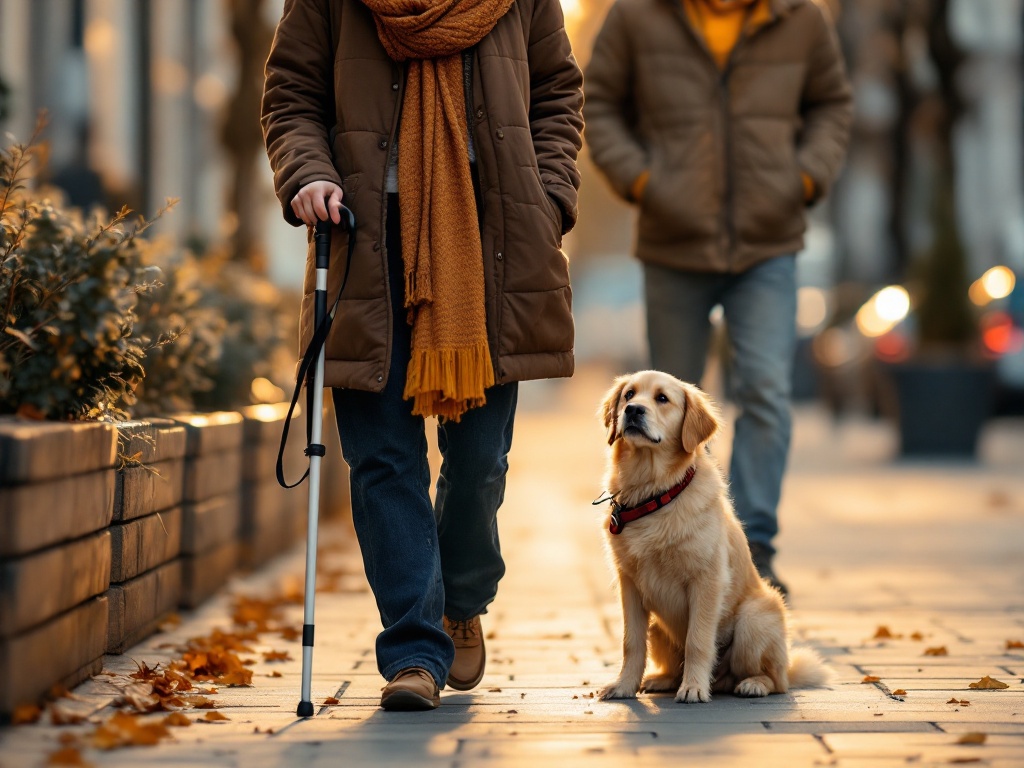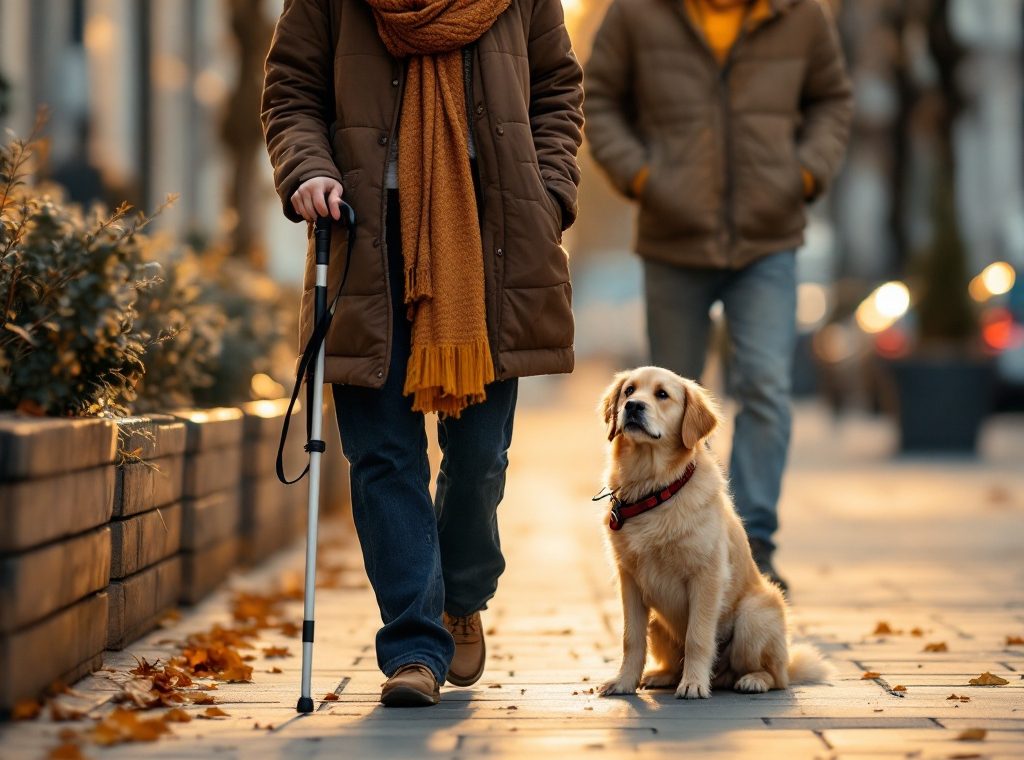Navigating the world with confidence is a challenge for the visually impaired. Discover essential travel aids like white canes, guide dogs, and cutting-edge electronic devices that empower blind individuals. Learn about the different types of canes, the benefits of guide dogs, and how GPS apps and specialized devices offer crucial support. Explore how these tools enhance independence and safety, opening up a world of possibilities. Read on to find the perfect travel aid to fit your needs.
Important information
- White canes are crucial mobility tools, helping visually impaired individuals detect obstacles and navigate their surroundings.
- Guide dogs offer invaluable navigation assistance and companionship, increasing independence and confidence.
- Electronic travel aids, including sonar canes and specialized GPS devices, use technology like echolocation to provide real-time environmental feedback and enhance navigation.
- GPS and mobility apps offer auditory directions, real-time information on public transport, points of interest, and accessible routes.
- Alternative mobility devices like walkers and rollators provide additional support for those with balance or upper body weakness.
Understanding the Role of a White Cane
A white cane is a crucial tool for people who are blind or have low vision. It acts as a tactile probe to detect obstacles and terrain changes. Its distinctive white color signals the user’s visual impairment, alerting others and potentially prompting assistance. The white cane enhances independence and promotes safer travel for individuals with vision loss.
What Are White Canes and Their Importance?
The white cane is an essential tool for people with low vision or blindness. It helps them navigate the world by detecting obstacles and identifying changes in elevation. The cane’s tactile feedback provides crucial information about the terrain, boosting confidence and promoting independence. Its distinctive white color alerts others to the user’s visual impairment, enhancing safety and encouraging assistance from drivers and pedestrians. More than a navigation tool, the white cane symbolizes self-reliance and freedom.
Types of White Canes and Their Functions
Support canes enhance balance and stability.
Probing canes, such as the long cane, detect obstacles and navigate terrain changes.
Identification canes are lightweight and signal visual impairment.
Choosing the Right Cane Tips for Different Terrains
Different cane tips suit various terrains. Standard tips are suitable for sidewalks, while marshmallow tips offer superior indoor traction. For covering longer distances, roller tips are an excellent choice.
Mastering Cane Techniques for Effective Travel
Mastering cane techniques requires practice and expert guidance from an Orientation and Mobility Specialist. This specialized training covers fundamental skills like the diagonal and two-point touch techniques, as well as advanced maneuvers for navigating complex environments such as stairs, escalators, and crowded areas. Developing a proper grip, maintaining good posture, and using the correct arc width are essential for effective cane use. Consistent practice builds confidence and promotes independent travel. Essential Cane Learning Techniques Learning cane travel is a progressive journey that builds essential mobility and navigation skills. Initially, users master fundamental techniques like the diagonal and touch methods. Later, more advanced skills, such as trailing and constant contact, are introduced. The training also covers navigating diverse terrains, including stairs and crowded areas. Formal instruction from a certified Orientation and Mobility Specialist is vital for safe and effective cane use. The Benefits of Using a Trained Guide Dog Guide dogs offer incredible independence and freedom, expertly navigating complex environments and busy public spaces. These highly trained companions enhance safety by skillfully avoiding obstacles and alerting their handlers to potential hazards. Moreover, studies show that guide dogs foster social interaction, reducing feelings of isolation and improving overall well-being through constant companionship and emotional support. They also instill confidence and boost self-esteem, truly transforming the lives of their handlers. How Guide Dogs Assist in Safe Travel Guide dogs are expertly trained to navigate complex environments, skillfully leading their handlers around obstacles such as curbs, stairs, and overhead hazards. Importantly, these dogs learn “intelligent disobedience,” refusing commands that could compromise their handler’s safety. This remarkable partnership fosters independence and confidence in visually impaired individuals. Guide dogs provide not only physical guidance but also crucial emotional support, reducing anxiety, especially in unfamiliar situations. They are truly invaluable companions.
Support and Probing Canes: Essential Tools Canes offer essential support, helping people with balance issues maintain stability. Probing canes, typically white, serve a distinct function by detecting obstacles and terrain changes. This vital tool enables safe travel and grants independence to those with visual impairments.
Differences Between Support Canes and Probing Canes
Support canes enhance balance and stability, aiding mobility.
Probing canes detect obstacles and terrain changes, facilitating exploration.
This distinction is crucial.
Alternative Mobility Devices (AMDs) for Enhanced Accessibility Alternative Mobility Devices (AMDs) offer significant assistance to individuals who find white canes insufficient. These devices, such as walkers, crutches, and rollators, enhance accessibility and mobility. They are particularly beneficial for those with upper body weakness or balance issues, providing valuable support for easier movement.
Features and Benefits of Alternative Mobility Devices Alternative Mobility Devices (AMDs), such as electronic travel aids and smart canes, offer valuable features. These features include GPS navigation, obstacle detection, and sensory feedback. They empower users by increasing independence and enhancing both safety and environmental awareness.
Wearable and Electronic Travel Aids for the Blind Wearable electronic travel aids, such as smart glasses and GPS devices, offer incredible support for visually impaired travelers by providing real-time information about their surroundings. Ultrasonic devices further enhance navigation by using sound waves to detect obstacles, delivering crucial auditory or tactile feedback to the user. Obstacle-detecting canes and GPS-enabled smartphones also prove valuable in increasing independence and safety for blind individuals. These aids empower visually impaired people to navigate unfamiliar environments with greater confidence and ease.
How Electronic Travel Aids Enhance Navigation Electronic travel aids (ETAs) empower visually impaired individuals by leveraging technology for navigation. Employing GPS and sensors, ETAs provide real-time environmental information, enabling users to detect obstacles, identify landmarks, and plan routes. Here are some examples of ETAs:
- specialized GPS systems designed for the blind,
- smart glasses with object recognition,
- electronic canes that sense obstacles.
These tools enhance both independence and safety for users.


















